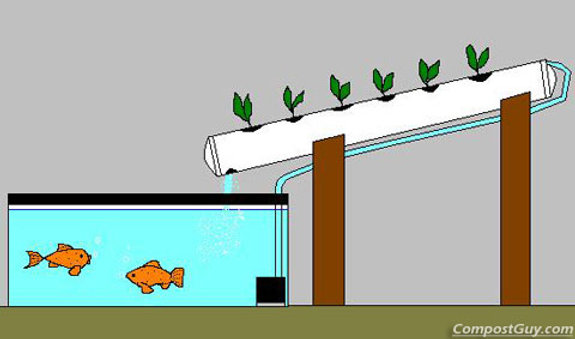
Do it yourself aquaponics

If you've been thinking about
gettng started with permaculture why not try a simple aquaponics
set up?
You take advantage of the
fish waste by having the water pumped up to a reservoir holding the
plants in place with some sort of medium like sand or gravel that
easily drains.
Photo credit goes to the CompostGuy.com who has a great section on his
experiences with do it yourself aquaponics. If that floats your boat
you might want to check out this short
video from permaculture expert Sepp Holzer and his impressive pond set up in
Austria.
Want more in-depth information? Browse through our books.
Or explore more posts by date or by subject.
About us: Anna Hess and Mark Hamilton spent over a decade living self-sufficiently in the mountains of Virginia before moving north to start over from scratch in the foothills of Ohio. They've experimented with permaculture, no-till gardening, trailersteading, home-based microbusinesses and much more, writing about their adventures in both blogs and books.
Want to be notified when new comments are posted on this page? Click on the RSS button after you add a comment to subscribe to the comment feed, or simply check the box beside "email replies to me" while writing your comment.

Have you seen WindowFarms.org's website? I think there is also something similar there ... I know when I saw it I started thinking how the whole thing could be set up to run out of a fish tank.
Thank you for your posting. I'm just starting my own blog and am amazed at the level of hours needed to research to be able to write informative articles! And I really like what you post :*)
Any micronutrients that you know of that don't dissolve in water (and if so, how do plants even absorb them)?
If not, it should be doable to feed plants properly with aquaponics.
Personally I think it should be able to work, hence my question.
My assumption was that solid nutrients and those that don't dissolve in water will not reach plants, unless the plants (or their symbionts) come into direct contact with them.
If the nutrients that plants need dissolve in water, they are probably actually transported to the plants roots by water. If that is the case, it shouldn't really matter if the plants are planted in soil or in another medium (or even without medium), as long as there is nutrient-rich water.
Of course I'm simplifying things here. But am I wrong about the basics?
Roland --- Ah, now I understand where you're coming from. Some micronutrients are much more water soluble than others --- that's why certain ones leech out of soil in heavy rains while others don't.
Some micronutrients are much more water soluble than others --- that's why certain ones leech out of soil in heavy rains while others don't.
That said, the real reason I think you'd have micronutrient problems in an aquaponics setup is because you're counting on the fish to provide all of the micronutrients the plants need. In a soil situation, there's quite a micronutrient buffer due to minerals in the bedrock ending up in the dirt, but water is likely to only have a few micronutrients in addition to the ones that are excreted by the fish. In essence, you're setting up a very simple closed loop in the water, while, in soil, not only are micronutrients added in your compost and mulch, but also deep-rooted dynamic accumulators can suck up those that leech into the subsoil.
Another factor to consider is that mychorrizhae are responsible for bringing several nutrients to plants, ones that aren't very soluble in water. Those fungi wouldn't be present in water, so crops that require mychorrizhae are less likely to do well.
Have you seen the old in ground pool that was converted into a complete hydroponics green house system? He raises talapia in the partially filled pool and pumps the water up to chickens and vegetables. Pretty amazing, if you ask me.
http://video.nationalgeographic.com/video/national-geographic-channel/shows/doomsday-preppers/ngc-self-sustaining-suburbia/
With aquaponics you have to manage both fish and plants. Maybe organic hydroponics would be more to your liking because it uses microorganisms to convert organic fertilizer into the inorganic nutrients that the plants need.
From what I've read sofar, it seems that aeroponics can be en even better alternative than hydroponics because it requires less nutrients and much less water. On first sight I see no reason why one shouldn't be able to use aeroponics with a nutrient solution created by breaking down organic fertilizer with micro-organisms.
OTOH, this might be just my bias talking, since as an engineer I tend to prefer technological solutions.